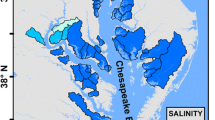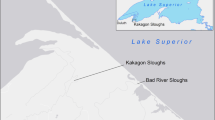Abstract
Effective tidal marsh restoration requires predictive models that can serve as planning and design tools to answer basic questions such as which, if any, plant species will colonize a proposed restoration site. To develop such a tool, a predictive model of oligohaline tidal marsh vegetation was developed from reference marshes in the Skagit River Delta (Washington, USA) and applied to a 1.1-ha restoration treatment site. Probability curves for the elevational distributions of common marsh species were generated from RTK-GPS point samples of reference tidal marshes. The probability curves were applied to a LIDAR-derived digital elevation model to generate maps predicting the occurrence probability of each species within treatment and control sites. The treatment and control sites, located within a recently restored area that had been diked but never completely drained, were covered by a mono-culture of non-native Typha angustifolia L. (narrow-leaf cattail) growing 40–60 cm lower in elevation than in the reference marsh. The T. angustifolia was mowed repeatedly in the treatment site to allow colonization by predicted native marsh species. Four years after mowing, T. angustifolia was replaced on 60 % of the treatment site by native sedges (Carex lyngbyei, Eleocharis palustris), consistent with the predictive vegetation model; the control site remained covered by T. angustifolia. The mowing experiment confirmed that pre-emptive competition from T. angustifolia was preventing vegetation recovery in the restoration site following dike removal, and implied that some vegetation species may be refractory to environmental change, such as dike removal or sea-level rise, because of differences in recruitment and adult niches.








Similar content being viewed by others
References
Adams DA (1963) Factors influencing vascular plant zonation in North Carolina salt marshes. Ecology 44:445–456
Alber M, Swenson EM, Adamowicz SC, Mendelssohn IA (2008) Salt marsh dieback: an overview of recent events in the US. Estuar Coast Shelf Sci 80:1–11
Babson AL, Kawase M, MacCready P (2006) Seasonal and interannual variability in the circulation of Puget Sound, Washington: a box model. Atmos Ocean 44:29–45
Ball JP (1990) Influence of subsequent flooding depth on cattail control by burning and mowing. J Aquat Plant Manage 28:32–36
Ball J, Bauer RD, Vermeer K, Rabenberg MJ (1989) Northwest riverine and Pacific Coast. In: Smith LM, Pederson RL, Kaminski RM (eds) Habitat management for migrating and wintering waterfowl in North America. Texas Tech University Press, Lubbock, pp 429–449
Beals EW (1969) Vegetational change along altitudinal gradients. Science 165:981–985
Benot M, Bonis A, Mony C (2010) Do spatial patterns of clonal fragments and architectural responses to defoliation depend on the structural blue-print? An experimental test with two rhizomatous Cyperaceae. Evol Ecol 24:1475–1487
Bertness MD, Ellison AM (1987) Determinants of pattern in a New England salt marsh plant community. Ecol Monogr 57:129–147
Bertness MD, Leonard GH (1997) The role of positive interactions in communities: lessons from intertidal habitats. Ecology 78:1976–1989
Bottom DL, Simenstad CA, Burke J, Baptista AM, Jay DA, Jones KK, Casillas E, Schiewe MH (2005) Salmon at river’s end: the role of the estuary in the decline and recovery of Columbia River salmon. US Department of Commerce, NOAA Tech Memo, NMFS-NWFSC-68
Budelsky RA, Galatowitsch SM (2000) Effects of water regime and competition on the establishment of a native sedge in restored wetlands. J Appl Ecol 37:971–985
Colwell RK, Rangel TF (2009) Hutchinson’s duality: the once and future niche. Proc Natl Acad Sci 106:19651–19658
Crain CM, Silliman BR, Bertness SL, Bertness MD (2004) Physical and biotic drivers of plant distribution across estuarine salinity gradients. Ecology 85:2539–2549
Davis F, Goetz S (1990) Modeling vegetation pattern using digital terrain data. Landsc Ecol 4:69–80
Doak DF, Morris WF (2010) Demographic compensation and tipping points in climate-induced range shifts. Nature 467:959–962
Donnelly JP, Bertness MD (2001) Rapid shoreward encroachment of salt marsh cordgrass in response to accelerated sea-level rise. Proc Natl Acad Sci 98:14218–14223
Elith J, Leathwick JR (2009) Species distribution models: ecological explanation and prediction across space and time. Ann Rev Ecol Evol Syst 40:677–697
Ewing K (1983) Environmental controls in Pacific Northwest intertidal marsh plant communities. Can J Bot 61:1105–1116
Farnsworth EJ, Meyerson LA (2003) Comparative ecophysiology of four wetland plant species along a continuum of invasiveness. Wetlands 23:750–762
Franklin J (1995) Predictive vegetation mapping: geographic modelling of biospatial patterns in relation to environmental gradients. Progr Phys Geogr 19:474–499
Grace JB, Harrison JS (1986) The biology of Canadian weeds. 73. Typha latifolia L., Typha angustifolia L. and Typha × glauca Godr. Can J Plant Sci 66:361–379
Grace JB, Wetzel RG (1981) Niche differentiation between two rhizomatous plant species: Typha latifolia and Typha angustifolia. Can J Bot 60:46–57
Heikkinen RK, Luoto M, Araújo MB, Virkkala R, Thuiller W, Sykes MT (2006) Methods and uncertainties in bioclimatic envelope modeling under climate change. Progr Phys Geogr 30:751–777
Hood WG (2006) A conceptual model of depositional, rather than erosional, tidal channel development in the rapidly prograding Skagit River Delta (Washington, USA). Earth Surf Process Landf 31:1824–1838
Hood WG (2007) Large woody debris influences vegetation zonation in an oligohaline tidal marsh. Estuar Coasts 30:441–450
Hood WG (2010) Tidal channel meander formation by depositional rather than erosional processes: examples from the prograding Skagit River Delta (Washington, USA). Earth Surf Process Landf 35:319–330
Jordan TE, Whigham DF (1988) The importance of standing dead shoots of the narrow leaved cattail, Typha angustifolia L. Aquat Bot 29:319–328
Kirwan ML, Kirwan JL, Copenheaver CA (2007) Dynamics of an estuarine forest and its response to rising sea level. J Coast Res 23:457–463
Legendre P, Legendre L (1998) Numerical ecology, 2nd English edn. Elsevier, Amsterdam
Martínez-Taberner A, Ruiz-Perez M, Mestre I, Forteza V (1992) Prediction of potential submerged vegetation in a silted coastal marsh, Albufera of Majorca, Balearic Islands. J Environ Manage 35:1–12
Pennings SC, Callaway RM (1992) Salt marsh plant zonation: the relative importance of competition and physical factors. Ecology 73:681–690
Pethick J (1993) Shoreline adjustments and coastal management: physical and biological processes under accelerated sea-level rise. Geogr J 159:162–168
Pidwirny MJ (1994) Competitive interactions and the spatial distribution of Carex lyngbyei and Scirpus americanus in a Pacific Northwest brackish tidal marsh. Dissertation, Simon Fraser University
Raxworthy CJ, Ingram CM, Rabibisoa N, Pearson RG (2007) Applications of ecological niche modeling for species delimitation: a review and empirical evaluation using day geckos (Phelsuma) from Madagascar. Syst Biol 56:907–923
Routledge RD (1987) Rhizome architecture for dispersal in the spike rush, Eleocharis palustris. Can J Bot 65:1218–1223
Sale PJM, Wetzel RG (1983) Growth and metabolism of Typha species in relation to cutting treatments. Aquat Bot 15:321–334
Sanderson EW, Ustin SL, Foin TC (2000) The influence of tidal channels on the distribution of salt marsh plant species in Petaluma Marsh, CA, USA. Plant Ecol 146:29–41
Sharma P, Asaeda T, Fujino T (2008) Effect of water depth on the rhizome dynamics of Typha angustifolia. Wetl Ecol Manage 16:43–49
Silvestri S, Defina A, Marani M (2005) Tidal regime, salinity and salt marsh plant zonation. Estuar Coastal Shelf Sci 62:119–130
Snow AA, Vince SW (1984) Plant zonation in an Alaskan salt marsh. J Ecol 72:669–684
Valiela I, Kinney E, Culbertson J, Peacock E, Smith S (2009) Global losses of mangroves and salt marshes. In: Duarte CM (ed) Global loss of coastal habitats: rates, causes and consequences. Fundación BBVA, Bilbao, pp 109–142
Vermeer K, Levings CD (1977) Populations, biomass and food habits of ducks on the Fraser delta intertidal area, British Columbia. Wildfowl 28:49–60
Wagner HH (2003) Spatial covariance in plant communities: integrating ordination, geostatistics, and variance testing. Ecology 84:1045–1057
Wright JW, Davies KF, Lau JA, McCall AC, McKay JK (2006) Experimental verification of ecological niche modeling in a heterogeneous environment. Ecology 87:2433–2439
Young TP, Petersen DA, Clary JJ (2005) The ecology of restoration: historical links, emerging issues and unexplored realms. Ecol Lett 8:662–673
Zedler JB, Callaway JC, Desmond JS, Vivian-Smith G, Williams GD, Sullivan G, Brewster AE, Bradshaw BK (1999) Californian salt-marsh vegetation: an improved model of spatial pattern. Ecosystems 2:19–35
Acknowledgments
Thanks to Heather Rogers and her Nature Conservancy volunteers who mowed the treatment site during the first season; to Perry Welch and his Skagit Fisheries Enhancement Group field crew who mowed the site subsequently; to Belinda Paxton, Len Rodriguez, and Jef Parr of the SRSC who contributed to the mowing effort; to Lora Leschner (Washington Department of Fish and Wildlife) for site access. Funding for reporting came from the Washington State Estuary and Salmon Restoration Program and an Environmental Protection Agency STAR Grant, # RD-83301401.
Author information
Authors and Affiliations
Corresponding author
Rights and permissions
About this article
Cite this article
Hood, W.G. Applying and testing a predictive vegetation model to management of the invasive cattail, Typha angustifolia L., in an oligohaline tidal marsh reveals priority effects caused by non-stationarity. Wetlands Ecol Manage 21, 229–242 (2013). https://doi.org/10.1007/s11273-013-9294-6
Received:
Accepted:
Published:
Issue Date:
DOI: https://doi.org/10.1007/s11273-013-9294-6




